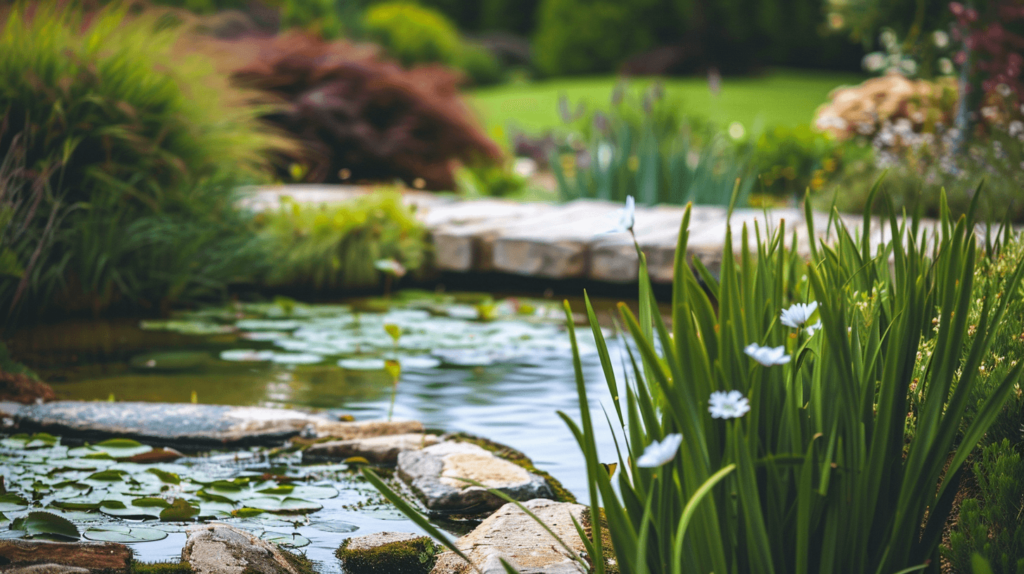Welcome to the green revolution in your backyard! As a passionate home improvement and decor enthusiast with a special love for the earth under our feet, I’m thrilled to embark on a journey with you into the heart of eco-friendly landscaping. In an era where sustainability is more than a buzzword—it’s a lifestyle—transforming your garden sustainably is not just about beautifying your outdoor space but making a conscious effort to nurture the planet.
Eco-friendly landscaping is an art and science that harmonizes aesthetic appeal with environmental stewardship. It’s about creating outdoor spaces that are not only beautiful and functional but also sustainable and in balance with the local ecosystem. This approach to gardening and landscaping has the power to reduce our ecological footprint, conserve precious resources like water, and create a haven for local wildlife, all while providing us with a serene and sustainable outdoor escape.
In this guide, we’ll explore the transformative power of sustainable gardening practices, from the magic of drought-resistant plants to the efficiency of water-saving garden designs. Whether you’re a seasoned gardener or a green-thumb-in-training, our journey will equip you with organic gardening tips, green landscaping techniques, and a treasure trove of sustainable garden ideas that promise to elevate your outdoor space into an eco-conscious paradise.
So, grab your gardening gloves and let your curiosity bloom as we dig into the essentials of eco-friendly landscaping. Together, we’ll turn the dream of an environmentally friendly garden into a lush, thriving reality that celebrates the beauty of nature and the innovative spirit of sustainable living.
Understanding Eco-Friendly Landscaping
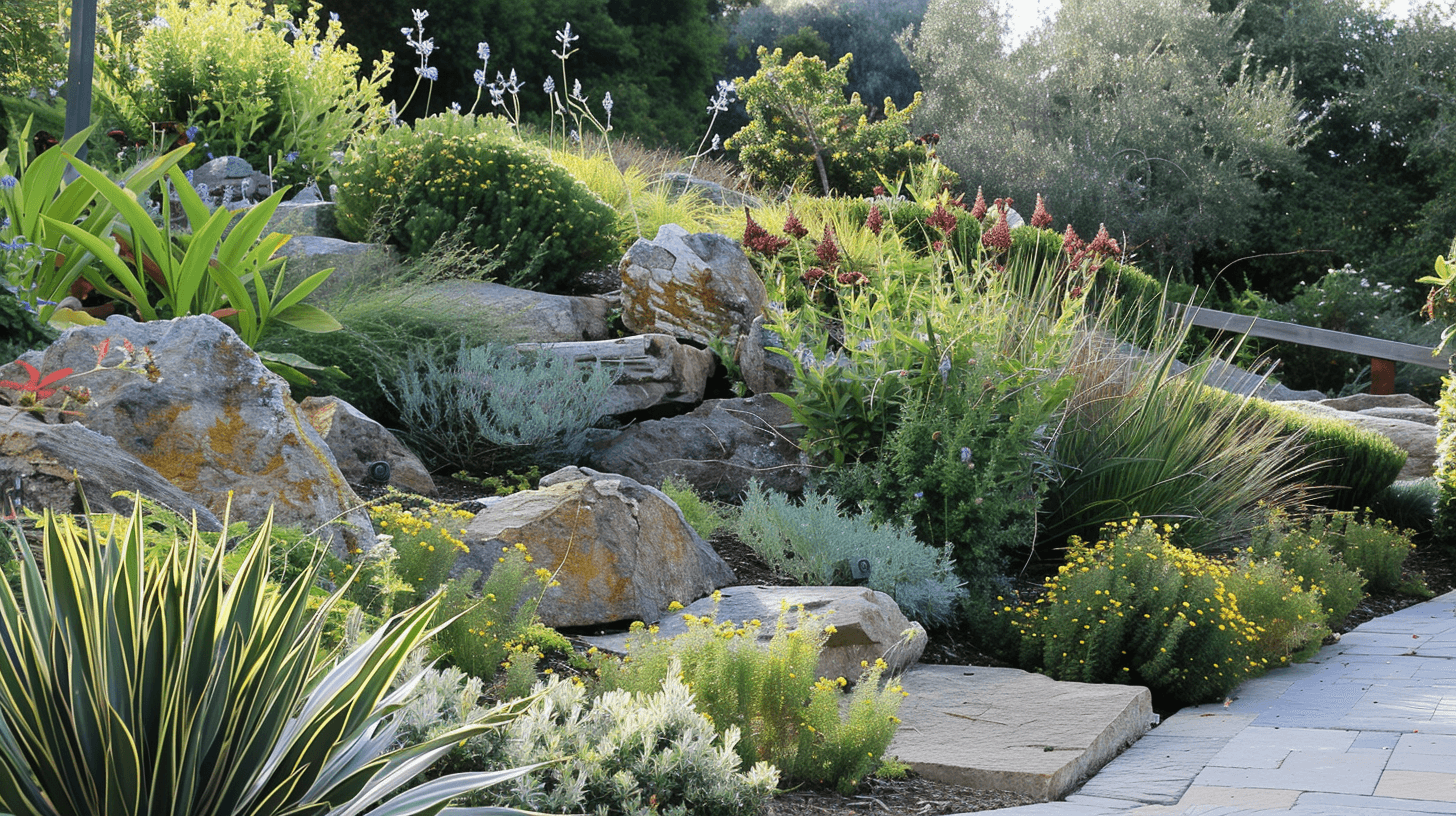
Eco-friendly landscaping, or green landscaping, is more than just a trend; it’s a meaningful shift towards embracing practices that protect and preserve the natural environment in our own backyards. At its core, eco-friendly landscaping focuses on designing, creating, and maintaining gardens that work in harmony with nature, rather than against it. This approach seeks to minimize both the environmental impact and the resources required for garden upkeep, including water, energy, and chemical inputs.
Core Principles of Eco-Friendly Landscaping:
- Sustainability: The practice revolves around choices that sustain themselves over time, requiring less water, fewer chemicals, and minimal intervention as they grow and mature.
- Biodiversity: Encouraging a diverse array of plant life that supports local wildlife, including birds, bees, butterflies, and beneficial insects, contributing to a healthy, balanced ecosystem.
- Soil Health: Prioritizing organic matter enrichment and natural fertilization techniques to maintain soil health, which is the foundation of a vibrant garden.
- Water Efficiency: Implementing water-saving garden designs and irrigation methods that reduce runoff and ensure every drop is utilized efficiently.
- Organic Practices: Reducing or eliminating the use of synthetic pesticides and fertilizers in favor of organic alternatives to promote a safer environment for all living beings.
Environmental Benefits:
Adopting eco-friendly landscaping techniques offers a plethora of environmental benefits. It helps in reducing water usage through drought-resistant planting and water-efficient gardening practices, thereby conserving a crucial resource. By emphasizing organic gardening techniques and minimizing chemical inputs, we contribute to cleaner waterways and soil, reducing pollution and enhancing the health of our local ecosystems.
Furthermore, green landscaping techniques support biodiversity by providing habitats for wildlife and beneficial insects. This not only contributes to the health of our planet but also brings the beauty of nature closer to home, creating sustainable outdoor spaces that are alive with the sights and sounds of the natural world.
Incorporating these principles into our landscaping efforts turns our gardens into
living ecosystems that not only thrive with minimal human intervention but also play a crucial role in combating climate change. Trees, shrubs, and other plants sequester carbon, helping to reduce the amount of CO2 in the atmosphere. Moreover, natural landscaping tips such as using native plants and creating shade can reduce the need for air conditioning, further decreasing our carbon footprint.
Eco-friendly landscaping is not just a method of gardening; it’s a philosophy that embraces the idea that our outdoor spaces can be beautiful, functional, and kind to the Earth all at once. By choosing to adopt green garden designs and sustainable practices, we take an active role in preserving the health of our planet for future generations while enjoying the immediate benefits of a natural, thriving garden.
In the following sections, we’ll explore how to plan and implement sustainable garden ideas, from selecting drought-resistant plants to incorporating organic gardening techniques and water-saving designs. Whether you’re looking to revamp your entire garden or incorporate a few eco-conscious choices, you’ll find inspiration and practical advice to make your green space a testament to sustainability and beauty.
Planning Your Sustainable Garden
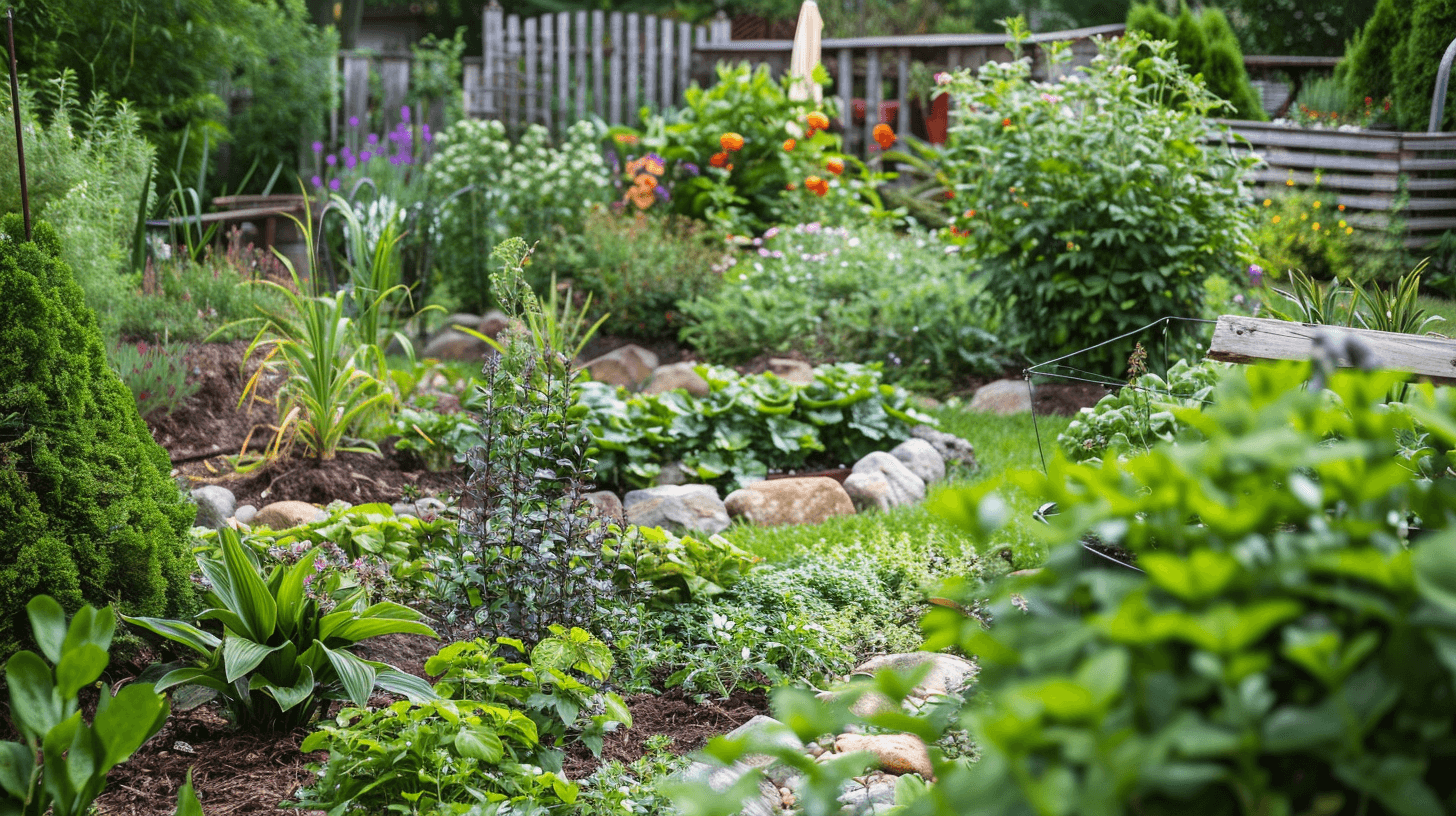
Creating an eco-friendly garden begins with thoughtful planning. It’s about making conscious choices that align with the principles of sustainability while catering to the aesthetics and functionality of your outdoor space. Here are key considerations and steps to help you lay the groundwork for a garden that is both beautiful and beneficial to the environment.
1. Assess Your Environment
- Understanding Your Space: Start by assessing the natural conditions of your garden. Observe sunlight patterns, soil type, and moisture levels. This knowledge will help you select plants that are suited to your garden’s specific conditions, reducing the need for additional resources such as water and fertilizers.
- Choosing Native Plants: Opt for native plants whenever possible. They are adapted to your local climate and soil, require less water, are more resistant to pests, and provide essential habitat for local wildlife, supporting biodiversity.
2. Design with Water Efficiency in Mind
- Water-Saving Garden Designs: Implement design strategies that conserve water. Consider xeriscaping, which utilizes drought-resistant plants to reduce water use, and incorporate mulching to retain soil moisture.
- Rainwater Harvesting: Explore rainwater harvesting systems to collect and use rainwater for irrigation, further reducing your garden’s demand on the municipal water supply.
3. Soil Health and Organic Matter
- Enriching Soil Naturally: Healthy soil is the foundation of a sustainable garden. Enhance your soil’s health by adding compost and organic matter, which improve soil structure, moisture retention, and nutrient availability.
- Natural Fertilizers: Choose organic fertilizers over synthetic ones. Organic options release nutrients more slowly and improve soil health over time, supporting sustainable growth.
4. Sustainable Landscaping Features
- Incorporate Eco-Conscious Hardscaping: Use recycled or locally sourced materials for paths, borders, and other hardscaping elements. Permeable paving options allow water to seep through, reducing runoff and replenishing groundwater.
- Attracting Wildlife: Design your garden to attract pollinators and beneficial insects by including a variety of plants that flower at different times of the year. Consider installing birdhouses, bee hotels, and water features to support local wildlife.
5. Planning for Growth and Change
- Flexibility in Design: Acknowledge that your garden will evolve over time. Choose plants that can grow and spread, filling in spaces naturally. This reduces the need for frequent replanting and allows your garden to develop a balanced ecosystem.
6. Sustainability Beyond the Plants
- Eco-Friendly Maintenance Practices: Plan for sustainable maintenance practices such as manual weeding, natural pest control methods, and efficient watering systems like drip irrigation to minimize water waste.
Planning your sustainable garden is a rewarding process that not only contributes to the health of the planet but also creates a space of beauty and tranquility for you to enjoy. By considering the environment in every step of the planning process, you’re laying the foundation for a garden that thrives in harmony with nature.
Sustainable Gardening Practices
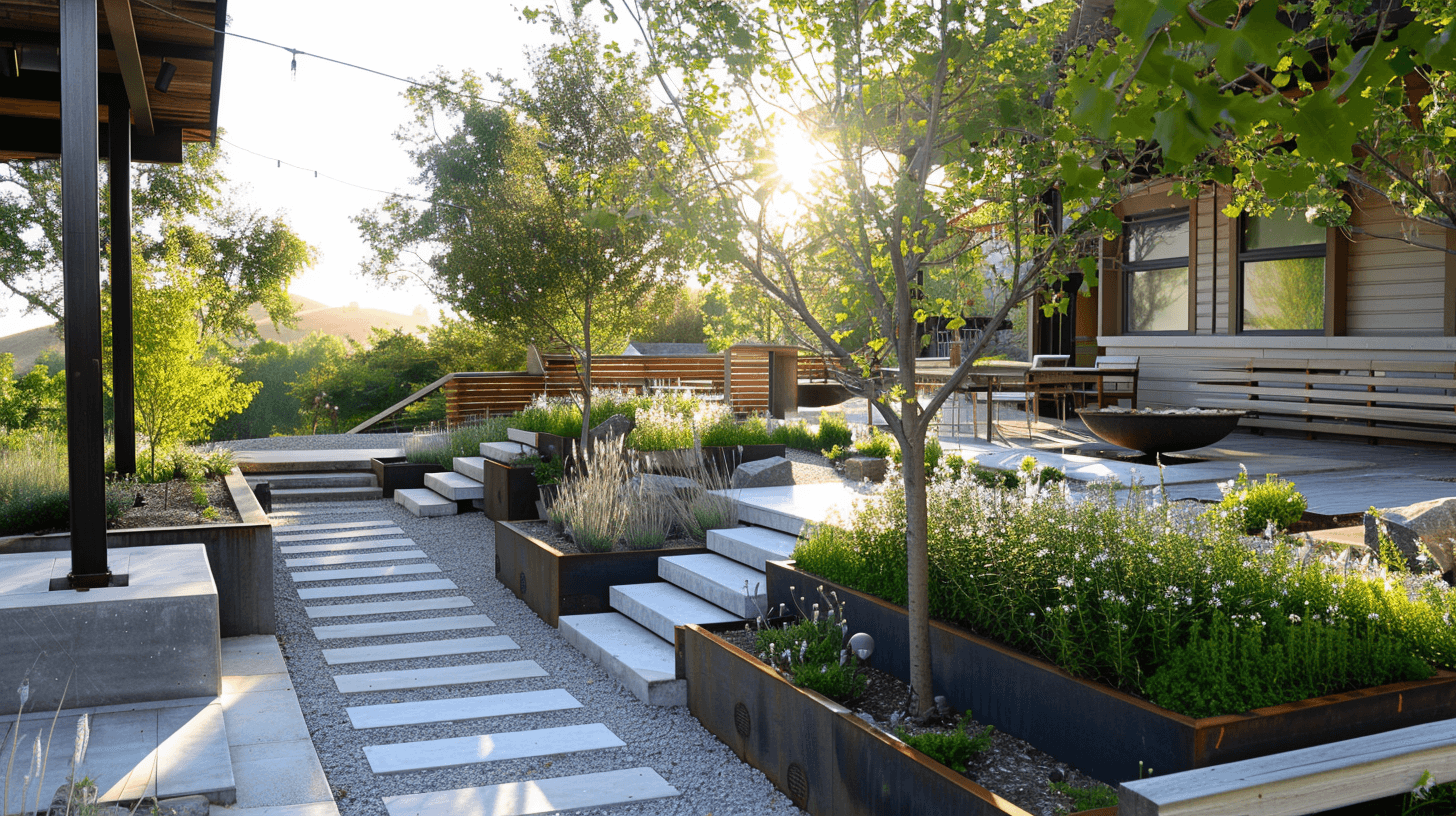
Adopting sustainable gardening practices is a powerful way to enhance the eco-friendliness of your outdoor space. These methods not only support the environment but also create a more resilient and low-maintenance garden. Here’s how you can implement these practices:
1. Composting and Organic Matter Recycling
- Turning Waste into Gold: Composting kitchen scraps and garden waste reduces landfill contributions and provides rich, organic matter to nourish your garden. This natural fertilizer improves soil structure and fertility, encouraging healthy plant growth.
- Mulching for Moisture and Weed Control: Applying organic mulch, such as shredded leaves or bark, helps retain soil moisture, regulate temperature, and suppress weeds, reducing the need for water and herbicides.
2. Water Conservation Techniques
- Drip Irrigation and Soaker Hoses: Installing drip irrigation systems or soaker hoses delivers water directly to the base of plants, minimizing evaporation and ensuring that water goes where it’s needed most.
- Timing Is Everything: Water your garden during the early morning or late evening to reduce water loss due to evaporation. Using a rain barrel to collect and store rainwater for garden use is another effective way to conserve.
3. Organic Gardening Techniques
- Natural Pest Management: Embrace organic gardening by using natural pest control methods. Introducing beneficial insects, such as ladybugs and lacewings, can help manage pest populations without harmful chemicals.
- Plant Diversity: Cultivating a diverse mix of plants can deter pests and diseases naturally. Including a variety of species creates a more balanced ecosystem, reducing the likelihood of widespread issues.
4. Drought-Resistant Planting
- Embracing Drought-Tolerant Plants: Incorporate drought-resistant plants into your garden design. These plants require less water once established, making them ideal for sustainable landscaping.
- Adapting to Your Climate: Choose plants that are well-suited to your local climate conditions. Native plants are particularly beneficial as they are adapted to thrive in your area’s specific weather, soil, and water availability.
5. Sustainable Lawn Care
- Rethinking the Traditional Lawn: Consider reducing the size of your lawn or replacing it with ground covers, native grasses, or a wildflower meadow. These alternatives require less water, fertilizer, and maintenance.
- Eco-Friendly Lawn Maintenance: For areas where lawns are desired, practice eco-friendly lawn care by mowing less frequently, leaving grass clippings on the lawn as natural fertilizer, and watering wisely.
6. Encouraging Wildlife and Biodiversity
- Creating Habitats: Design your garden to attract and support wildlife. Bird baths, insect hotels, and native flowering plants can transform your garden into a haven for birds, bees, and butterflies.
- Promoting Pollinators: Planting a range of flowers that bloom at different times ensures a continuous food source for pollinators, vital for the health of your garden and the broader environment.
Sustainable gardening practices are at the core of eco-friendly landscaping. By adopting these approaches, you not only create a beautiful and productive garden but also contribute to a healthier planet. As we nurture our gardens, we also nurture the earth, fostering a deep connection with the natural world around us.
Drought-Resistant Planting and Water-Saving Techniques

1. Embracing Drought-Resistant Plants
Choosing the right plants is crucial for reducing water usage in your garden. Drought-resistant plants, often native to arid environments, have adapted to thrive with minimal water, making them perfect candidates for sustainable landscapes.
- Selecting the Right Species: Look for plants with deep root systems, succulent leaves, or gray foliage, as these traits often indicate drought resistance. Native plants are also excellent choices, as they are naturally adapted to the local climate and soil conditions.
- Grouping Plants by Water Needs: Practice hydrozoning by grouping plants with similar water requirements together. This ensures that each plant receives the right amount of water without overwatering or underwatering.
2. Innovative Water-Saving Garden Designs
Designing your garden with water conservation in mind can significantly reduce your landscape’s water demand.
- Incorporating Xeriscaping Principles: Xeriscaping is a landscaping philosophy that minimizes water use through careful plant selection, soil amendments, and efficient irrigation practices. It’s not just about rock gardens; it’s about creating lush, vibrant landscapes that require minimal irrigation.
- Utilizing Mulch and Ground Covers: Applying mulch helps retain soil moisture and reduce evaporation. Ground covers, such as creeping thyme or sedum, provide an attractive, low-maintenance alternative to traditional lawns, reducing the need for frequent watering.
3. Efficient Irrigation Practices
Effective irrigation is key to minimizing water use while keeping your garden thriving.
- Drip Irrigation Systems: Installing a drip irrigation system can dramatically reduce water waste by delivering water directly to the roots of plants, where it’s needed most.
- Smart Watering Practices: Equip your irrigation system with a smart controller that adjusts watering based on weather conditions, or use a soil moisture sensor to tailor watering schedules to actual soil moisture levels.
4. Harvesting and Utilizing Rainwater
Capturing rainwater is an excellent way to supplement your garden’s water needs sustainably.
- Installing Rain Barrels: Rain barrels can be easily connected to your downspouts to collect and store rainwater for garden use.
- Creating Rain Gardens: Design a rain garden in a low-lying area of your yard to capture runoff from your roof, driveway, or other impervious surfaces. Rain gardens allow water to infiltrate the ground, reducing runoff and providing moisture for plants.
5. Sustainable Lawn Alternatives
Consider reducing your reliance on traditional grass lawns, which are often water-intensive.
- Exploring Lawn Alternatives: Investigate alternatives to traditional turf that require less water, such as buffalo grass, clover lawns, or a mix of low-growing native plants.
- Reducing Lawn Size: Decrease the overall size of your lawn by expanding garden beds, adding hardscaping elements, or converting areas to native plantings or edible gardens.
Adopting drought-resistant planting and water-saving techniques is essential for creating an eco-friendly garden that thrives in today’s changing climate. By choosing the right plants and employing efficient water use strategies, you can enjoy a lush, vibrant garden that conserves water, supports local ecosystems, and stands as a testament to sustainable living.
Organic Gardening Techniques and Green Garden Designs
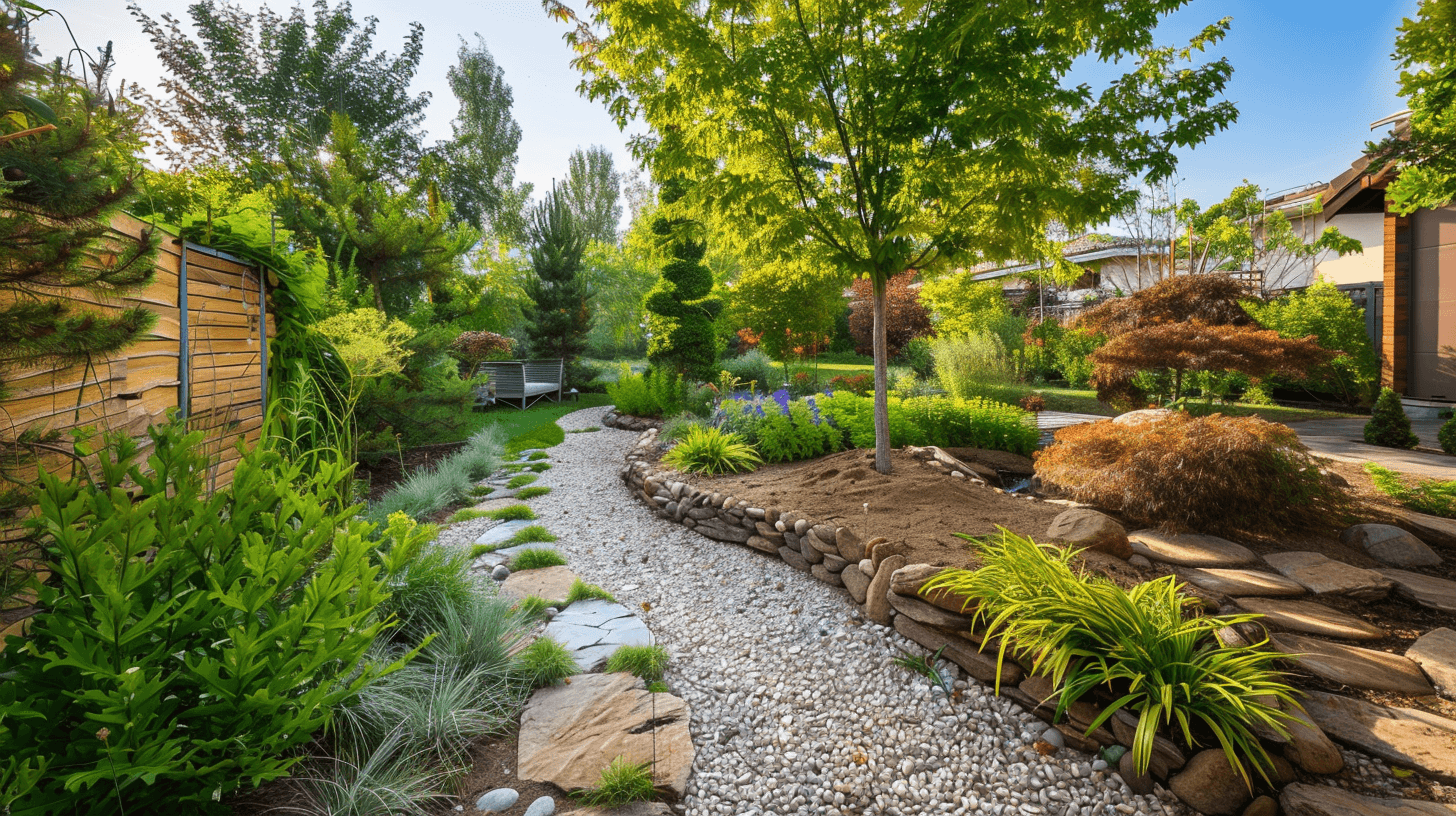
Organic Gardening: A Cornerstone of Eco-Friendly Landscaping
Organic gardening is pivotal in establishing an eco-friendly landscape. It emphasizes the use of natural processes and materials to nurture plants, enrich the soil, and manage pests and diseases, all without relying on synthetic chemicals.
- Soil Health and Nutrition: Begin with the soil—your garden’s foundation. Enrich it with compost and organic matter to improve structure, water retention, and fertility. Natural fertilizers, like compost tea or fish emulsion, provide essential nutrients without the harsh effects of chemical fertilizers.
- Pest and Disease Management: Adopt integrated pest management (IPM) strategies that focus on prevention and natural control methods. Encourage beneficial insects, use barriers or traps for pests, and apply natural remedies only as needed.
- Companion Planting: Leverage the natural relationships between plants to deter pests and enhance growth. For example, planting marigolds among vegetables can repel nematodes and other pests, while basil can help improve the flavor of tomatoes.
Green Garden Designs: Blending Aesthetics with Sustainability
Creating a green garden design involves more than just plant selection; it’s about crafting landscapes that are both beautiful and sustainable.
- Diverse Plantings: Design with biodiversity in mind to create a resilient and vibrant garden. Incorporate a mix of trees, shrubs, perennials, and annuals to support a wide range of wildlife.
- Natural Water Features: Incorporate naturalistic water features, like ponds or streams, that attract wildlife and provide irrigation. Position these features to capture runoff and utilize natural rainwater, further reducing water usage.
- Eco-Friendly Materials: Choose sustainable, locally sourced materials for hardscaping, borders, and paths. Recycled materials, permeable paving, and natural stone are excellent choices that blend seamlessly into green garden designs.
- Vertical Gardening: Make use of vertical spaces with trellises, wall planters, or climbing plants. This approach not only saves space but also adds an interesting dimension to your garden, perfect for small or urban areas.
Water-Efficient Gardening: Maximizing Resources
An integral part of organic gardening and green design is the efficient use of water, a precious and often limited resource.
- Rainwater Harvesting: Enhance your garden’s sustainability by collecting and using rainwater. Simple rain barrels or more complex systems can be incorporated to irrigate your garden naturally.
- Drought-Tolerant Landscaping: Emphasize plants that require minimal watering once established. Succulents, native grasses, and other drought-tolerant species can create a lush landscape that conserves water.
Sustainable Maintenance Practices
Maintaining your eco-friendly garden organically means adopting practices that ensure its health and longevity without adverse environmental impacts.
- Natural Mulches: Use organic mulches to suppress weeds, conserve moisture, and gradually enrich the soil as they decompose.
- Manual Weeding and Cultivation: Opt for manual weeding and use of hand tools to manage garden beds without the need for chemical herbicides or heavy machinery that can compact soil.
By integrating organic gardening techniques and green garden designs, you create an eco-friendly landscape that is not only a sanctuary for you and local wildlife but also a significant step towards a more sustainable and environmentally conscious way of living. Through mindful practices and a commitment to organic principles, your garden can thrive naturally, offering beauty, biodiversity, and a profound sense of connection to the natural world.
Nurturing Your Eco-Friendly Garden: A Sustainable Future
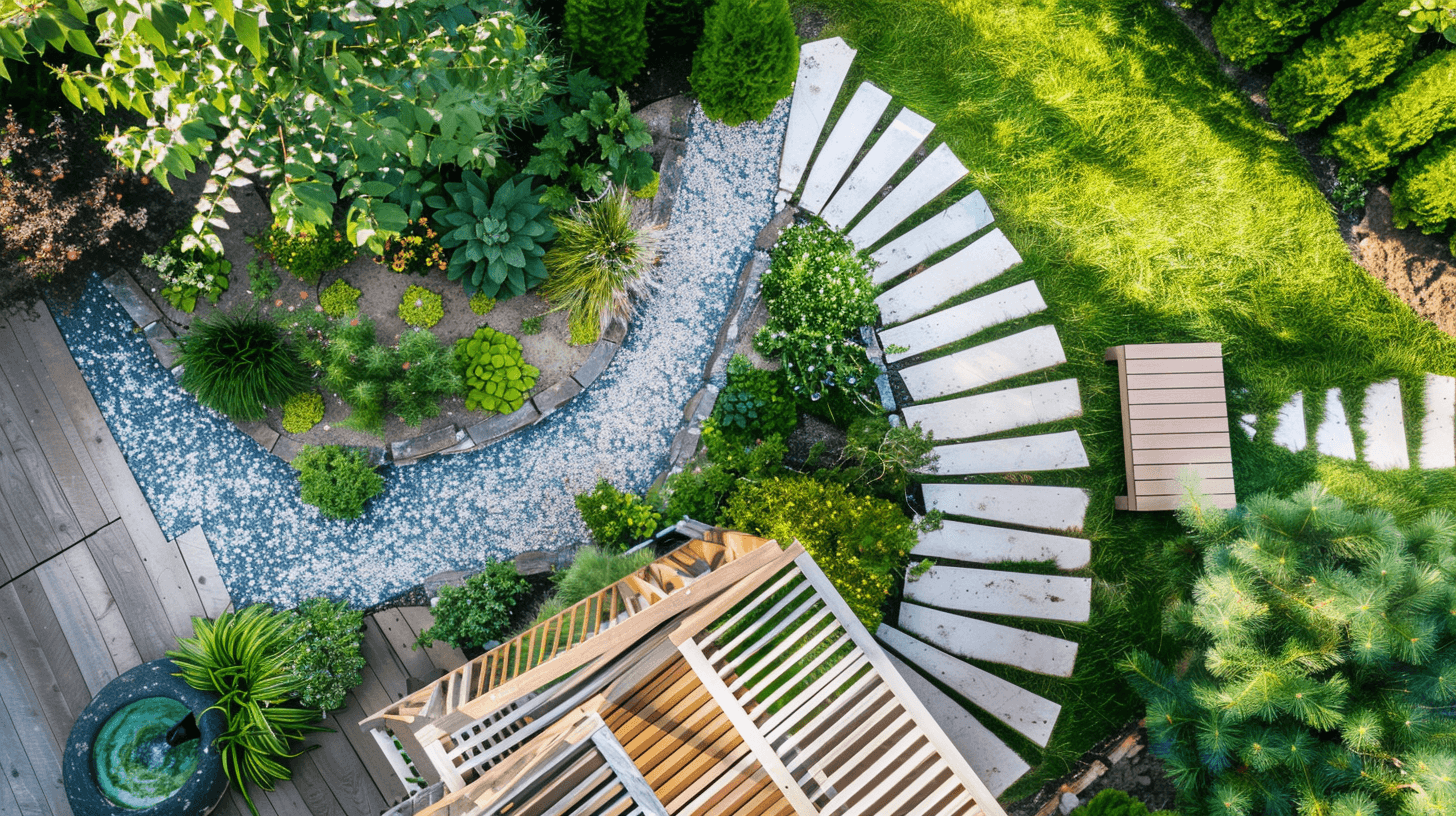
Continued Learning and Adaptation
The journey toward a truly sustainable garden is ongoing. As environmental conditions change and we learn more about the natural world, it’s important to remain open to new ideas and practices that can enhance the eco-friendliness of our outdoor spaces.
- Stay Informed: Keep up with the latest in sustainable gardening practices and environmental conservation efforts. Whether through books, workshops, or online forums, continuing to learn will help you adapt and refine your approach to eco-friendly landscaping.
- Experiment and Observe: Don’t be afraid to try new techniques or plant varieties. Observation is key to understanding what works best in your garden, allowing you to tailor your practices to meet its unique needs and challenges.
Building Community and Sharing Knowledge
One of the most powerful aspects of sustainable gardening is its ability to connect people—through the sharing of knowledge, experiences, and even the fruits of our labor.
- Engage with Local Gardening Communities: Whether it’s a community garden, a gardening club, or online social media groups, connecting with fellow gardeners can provide valuable support, inspiration, and shared joy in the successes (and sometimes failures) of gardening.
- Educate and Inspire Others: Share your journey and the lessons you’ve learned with friends, family, and your community. Hosting garden tours, writing a blog, or simply talking about your eco-friendly practices can inspire others to consider more sustainable approaches in their own gardens.
Advocating for Environmental Stewardship
As eco-friendly gardeners, we have the opportunity to not only impact our own slice of the earth but also contribute to broader environmental conservation efforts.
- Support Conservation Initiatives: Engage with and support local and global conservation efforts that protect natural habitats, promote biodiversity, and address climate change. Your garden is part of a larger ecosystem, and these initiatives help ensure its health and vitality.
- Practice and Promote Sustainability: Beyond the garden, embody the principles of sustainability in all aspects of your life. From reducing waste and conserving water to supporting renewable energy, every action contributes to a healthier planet.
Eco-friendly landscaping is more than just a method of gardening; it’s a reflection of our commitment to the environment and our desire to live in harmony with nature. By adopting sustainable practices, nurturing biodiversity, and sharing our knowledge and experiences, we contribute to a more sustainable world, one garden at a time.
As you continue to cultivate your eco-friendly garden, remember that every plant you nurture, every drop of water you save, and every choice you make in favor of sustainability is a step towards a healthier planet. Your garden is a living testament to the possibilities of sustainable living, offering inspiration and hope for a greener, more eco-conscious future.
Resources
Sustainable Jungle’s Guide to Eco-Friendly Landscaping: This comprehensive guide offers insights into using natural materials like cedar and pine bark mulch for their insect-repellent properties and soil health benefits. It emphasizes the importance of natural fertilizers, soil amendments, and innovative water-saving techniques, including rainwater harvesting and aquaponics. The guide also provides valuable advice on selecting plants that require minimal water and contribute to the biodiversity of your garden. A must-read for anyone interested in making their garden more planet-friendly.
Explore more at Sustainable Jungle.
Gardenista’s Sustainable Design Tips for Gardens: Gardenista provides detailed information on reducing rainwater runoff by utilizing permeable surfaces and other eco-friendly hardscape materials. Highlighting the effectiveness of decomposed granite, pea gravel, and ribbon driveways, the article also discusses rainwater capture options and eco-friendly alternatives to traditional turf. This resource is perfect for individuals looking to incorporate sustainable design elements into their garden.
Discover more design tips at Gardenista.
Belgard’s Green Landscaping Ideas: Belgard offers innovative ideas for creating and maintaining an eco-friendly yard. From smart irrigation systems and permeable pavers to recycling water and container gardening, Belgard covers a wide range of topics to help you save water and enhance the sustainability of your garden. The guide also touches on the importance of choosing the right plants and supporting pollinators to create a vibrant and eco-conscious outdoor space.
Learn more about Belgard’s eco-friendly yard solutions at Belgard.
Each of these resources provides unique perspectives and practical tips for embarking on or enhancing your eco-friendly landscaping journey. Whether you’re interested in sustainable gardening practices, organic gardening tips, or innovative water-saving techniques, these guides offer a wealth of information to help you create a more sustainable and beautiful garden.

